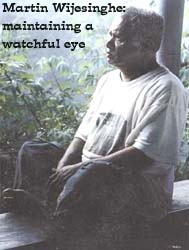

![]()
![]()
Over thirty years ago a young tracker named Martin Wijesinghe joined the Forest Department, bringing with him nothing, but a love for nature and an overwhelming desire to learn from the wilderness around him.
In the lone hills of southern Sri Lanka, there lies a belt of tropical rain forest called Sinharaja. Like all ancient forests, it once stretched out across the country, linking the burning coastline to the cool, lingering highlands.
The small fragment that remains now is the last for its kind, and its
survival into the present day has been ensured greatly by the efforts of
one man. 
Over thirty years ago a young tracker named Martin Wijesinghe joined the Forest Department, bringing with him nothing, but a love of nature and an overwhelming desire to learn from the wilderness around him. He was assigned to Sinharaja, and thus began a union that continues to this day.
Martin came at a time when environmental concerns were the last thing on most people's minds.
Even the powers that be were not overly concerned with the fast-deteriorating forest resources, and Sinharaja was low on their list of priorities.
As Martin's knowledge of the forest grew, so did his worries for its future.
Experts came and went, but none stayed long enough to absorb the real
necessity for the forest to be protected. The timber merchants from home
and abroad took their toll on the hardwoods and softwoods of the forest.
Tea estates swallowed up the surrounding lands, and slowly began to encroach over the forest's boundary. When Sinharaja was finally declared a strict National Reserve, it was barely a fraction of its former size.
Through it all, Martin stayed put, and in time became the foremost authority
on Sinharaja's plant and animal wealth. 
His knowledge of the forest's herbal plants, its unique insect life, and the secretive animals that hide within its depths, has made him an invaluable consultant to various conservation projects, and a respected teacher to hundreds of school children that have visited Sinharaja. And all from a humble tracker without a single qualification.
Martin has been awarded special commendations for his work, and has been granted residence in a department bungalow within the forest itself. From there, with his family, he works to keep the forest alive; maintaining a watchful eye on every leaf, and every feather, and every hair. Guarding the forest. Delivering it into the future.
 It
is rich in biodiversity - holding a great variety of species, that in turn,
occupy a great variety of ecological niches. The forest holds over 60%
of Sri Lanka's endemic species, 40% of which, occur nowhere else.
It
is rich in biodiversity - holding a great variety of species, that in turn,
occupy a great variety of ecological niches. The forest holds over 60%
of Sri Lanka's endemic species, 40% of which, occur nowhere else.
All the streams that flow out of the forest run clear with pure water.
Dense tree-cover creates high humidity, promoting rainfall in the surrounding
environment.
Local farmers learned this to their cost when crops grown on cleared forest land failed because of drought, and the exposed soil was eroded away.
Sinharaja contains the original, wild ancestors of many commercial tropical fruit crops. Primitive and small-fruited durian, sour-sap and rhambutan trees are found everywhere.
Continue to Plus page 2 * Patriotism with a gun in the hand
![]()
| HOME PAGE | FRONT PAGE | EDITORIAL/OPINION | NEWS / COMMENT | BUSINESS
Please send your comments and suggestions on this web site to
info@suntimes.is.lk or to
webmaster@infolabs.is.lk